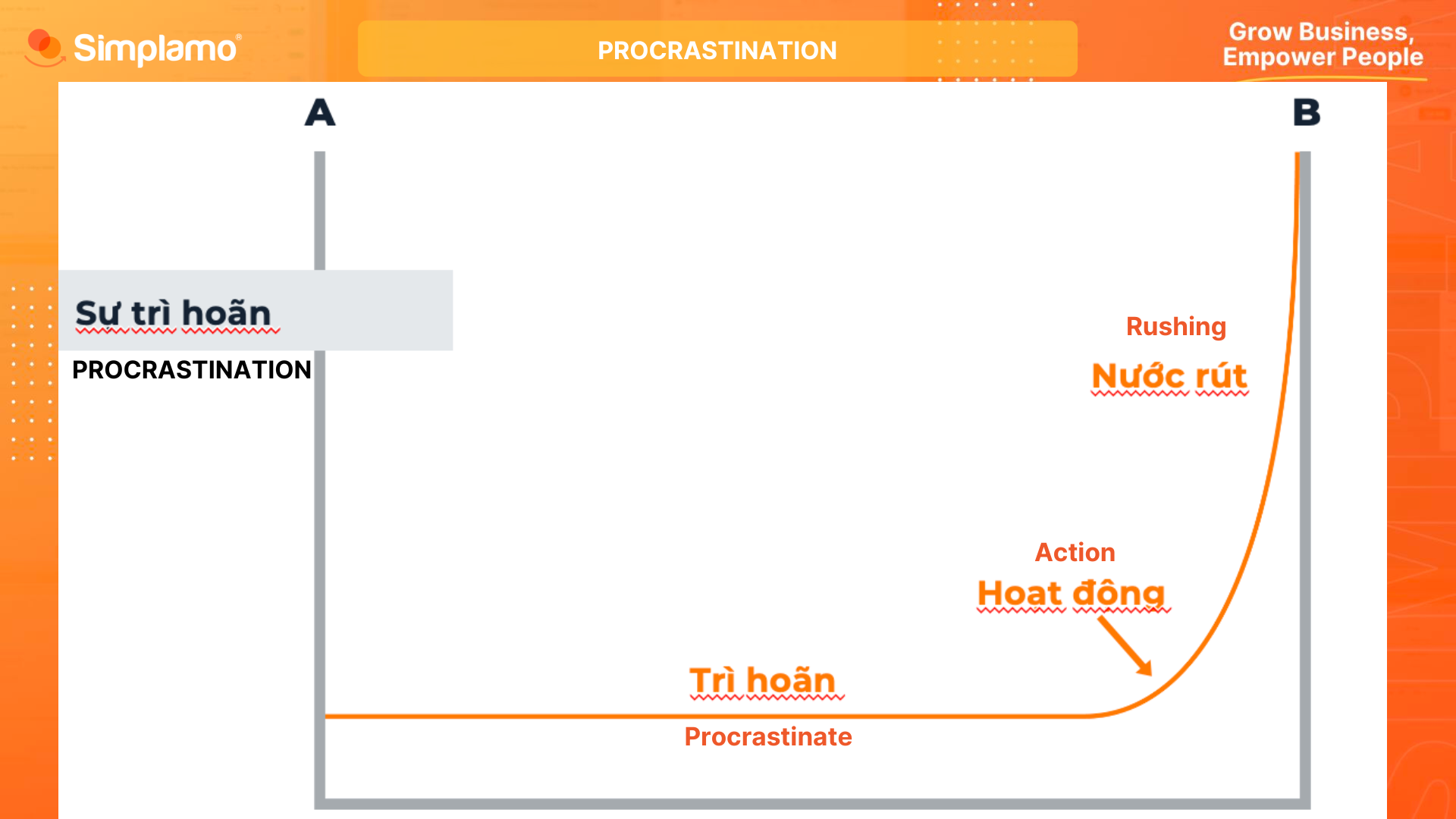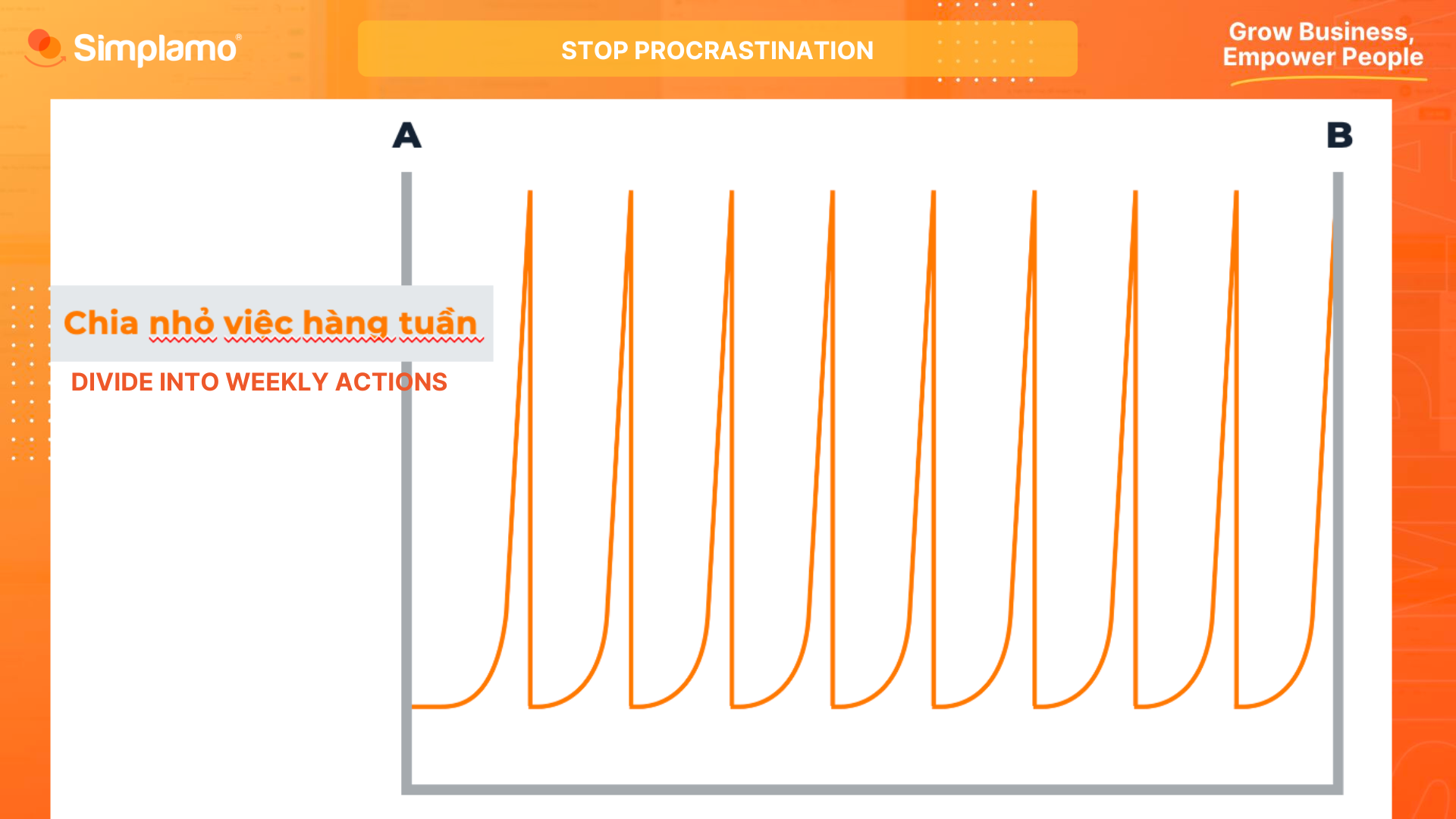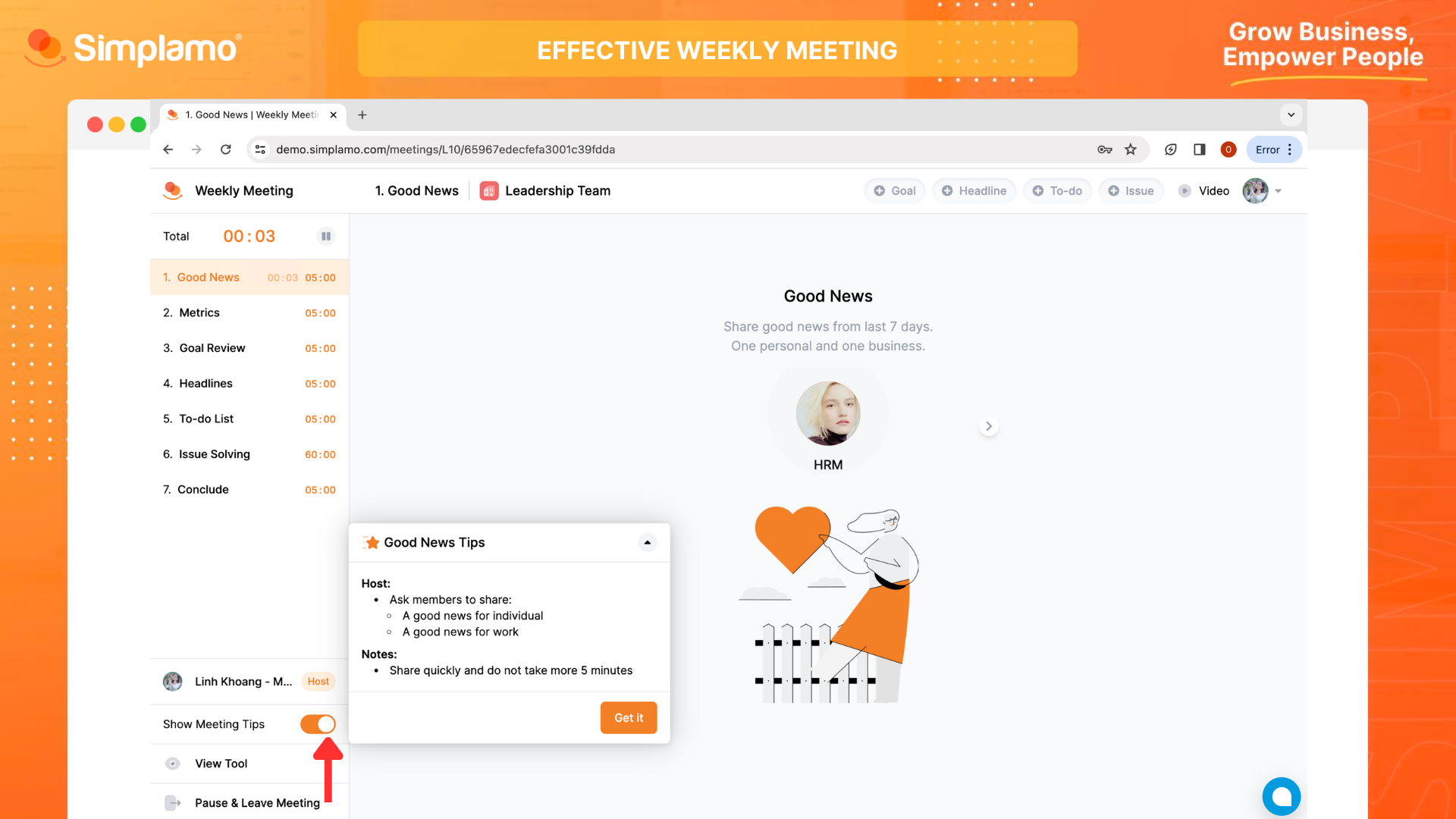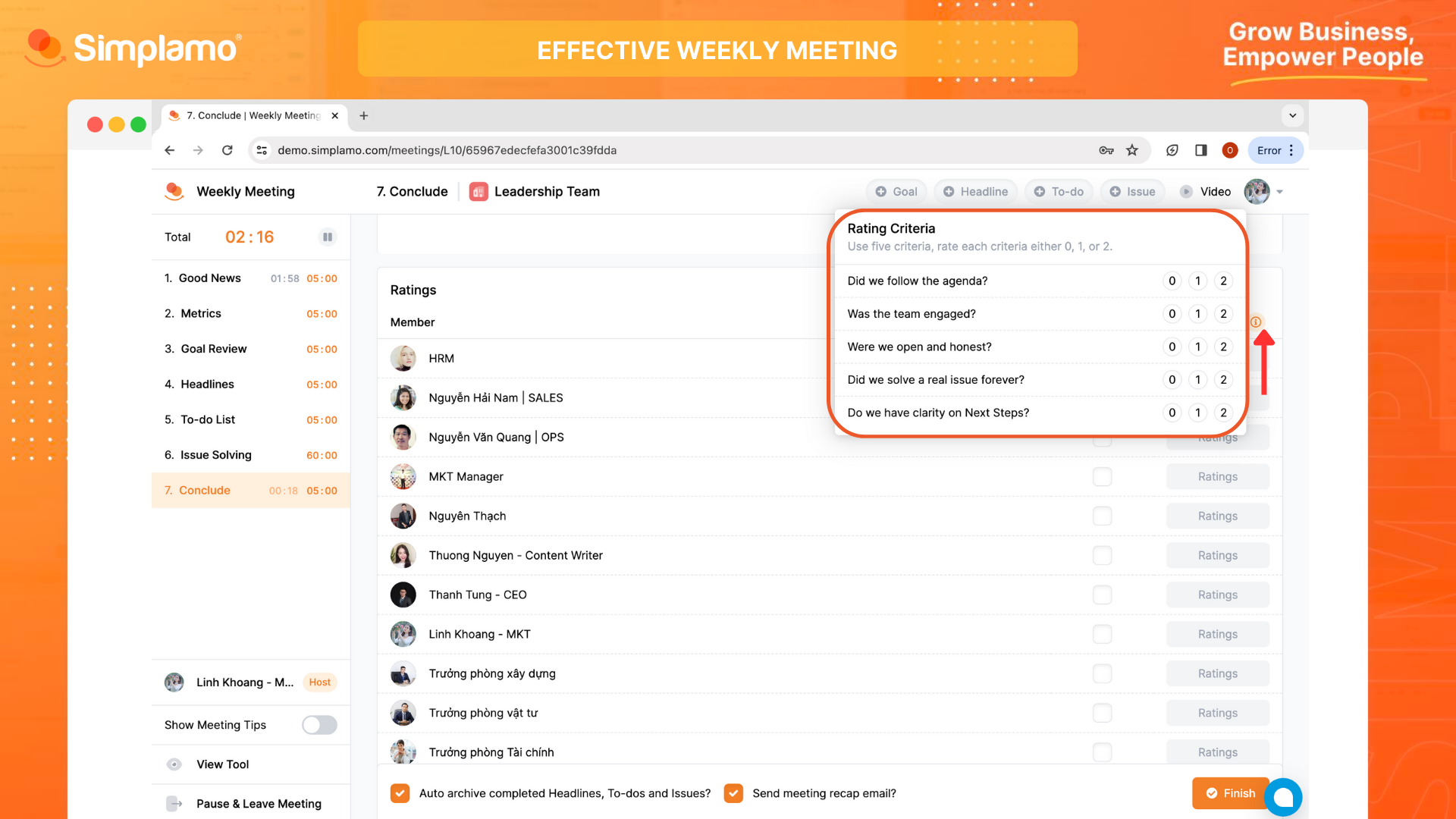Weekly Meeting
I. The Important
Most of the time, meetings are waste of time, with the key problem being that "everyone keeps talking endlessly without solving issue".
Additionally, most human beings by nature procrastinate, wait until the last minute to complete tasks.
The chart below illustrated by the following procrastination model. You have a meeting (call that Meeting A), and during it, people are usually assigned tasks. The line in picture below represents the activity to get that stuff done. Everyone tends to procrastinate until the last moments before Meeting B takes place.
So that If you only organize monthly meetings, this is precisely why the quality of work often falls short of expectations.

Due to the aforementioned reasons, Simplamo has established a weekly meeting frequency, which means you will have 52 meetings per year (instead of 12 monthly meetings).
By doing so, you create spike of activity more often, you reach a point where is no time to procrastinate. Help you and your team monitor goals execution more frequently, generating motivation to drive people to complete their tasks.

Great organizations minimizes the length of meetings while maximizing meeting productivity. The Weekly Meeting is simply having the right timing, with a consistent agenda to achieve 4 things:
- Ensuring all goals are being tracked.
- Maintaining a strong connection with the team.
- Hold each other accountable
- Addressing issues.
We’ve found that the best interval and length of a meeting for most teams is to have a 90-minute meeting every week. Let’s discover about it right now.
II. The Preparation
Remember some important points before the meeting as follows:
1. Personnel:
There are 2 vital roles that need to be coordinated during the meeting:
- Facilitator: This person runs and leads the meeting, ensuring everyone focuses on the agenda, time, and content of each section.
- Document scribe (Secretary): This person role involves data entry. He/She listens to the raised issues, proposals, discussions, etc., and take notes on Simplamo.
These two roles should be assigned to different people. Additionally, they should alternate between being the Facilitator and the Secretary, allowing any member to take on these roles.
On Simplamo, we have a button to guide for Facilitator by clicking on “Show Meeting Tips”.

2. Time:
Fix a specific time for the Weekly Meeting and inform all team members.
All weekly meeting must always take place on the same day and at the same time each week.
It also must start and end on time.
3. Results:
- Members who own Scorecards and Priority Objectives should update their results on Simplamo before the meeting.
- Prepare any "Issues" or barriers preventing you from achieving Scorecards and Priority Objectives to discuss during the Meeting.
- The Meeting is the designated for team members to raise any issues that need to be discussed, so create an "Issue List" throughout the session. The team will address them in Section 6 "Issue Solving".
Now let's learn about the significance and facilitation of each section of the meeting.
III. Agenda
1. Good news - 5 Mins
- Purpose: Start the meeting by sharing good news of last week. As an icebreaker, fostering a stronger connection among team members.
- Facilitation: The Facilitator will each member to share one piece of both personal and professional good news from the past week. The secretary doesn't need to take notes during this section.
2. Metrics Review - 5 Mins
Purpose: Review the business health indicators (Metrics) / Department Health indicators for the week. Ensure that owners are heading in the right direction to achieve the goals.
Facilitation:
- The Facilitator sequentially reviews the results of each indicator as "hit the goals" or "not" for the week.
- When comes across indicators that are in red color (mean didn’t hit the goal), let’s inquire the owner by asking, "Are you facing any problems?" The owner then simply responds with, "My issue is..."
- The Secretary assist in noting down these issues for discussion in Section 6.
- In this section, should be no questions, no comments, no apologies. If any member has a question, the Facilitator should say, "Let's discuss this issue later" to avoid diverting the discussion to less critical matters.
3. Goals Review - 5 Mins
Purpose: Review all Company & Department objectives execution in the quarter.
Facilitation: This is a reporting-oriented session.
- The Facilitator invites each member to report on their objective as "On track" or "Off track."
- If any Goals is off track or the milestone is late, the question should be: “What issue have you encountered with this milestone? or Do we need to create an issue to discuss?".
- The owner then simply responds with, "My issue is..."
- When an issue is raised, the secretary takes note on Simplamo to discuss later.
- To avoid distractions, it's best not to ask any questions or make comments during the meeting. If any additional topics come up, the Facilitator simply suggests, "Let's create an issue and discuss it later".
4. Headlines - 5 Mins
Purpose: Record prominent feedback (both positive and negative) from customers, partners, suppliers, and internal staff.
Facilitation:
The Facilitator asks team members, "Have you received any feedback from customers and employees in the past week?"
Each member provides concise feedback in 1 to 2 sentences following this structure:
[Customer Name] [Feedback Content]
[Employee Name] [Feedback Content]
Example:
- "Customer A provided positive feedback about Thao's enthusiastic and professional support." (a), or
- "The Sales Department expressed disappointment with the project team's work progress." (b)
→ In case of negative feedback like example (b), the Facilitator should confirm with team members whether they need to "Add to the issue list" for further discussion or not.
5. To-Do List - 5 Mins
Purpose: Review the action item list to ensure completion.
This list consists of commitments or actions that were accepted and agreed to address the issues from the previous weekly meetings.
Facilitator:
- Mark actions that have been completed as "Done."
- If a To-do hasn't been completed, it should remain on the list and the deadline should be extended by one week or raise issues if any.
The goal is that your team collectively completes 90% of them each week before the meeting.
6. Issue Solving - 60 Mins
Note: In this section, besides issues, it can also be an announcement, a proposal, or a concern that all participants want to discuss.
Purpose: Address the issues raised by all participants during Sections 1 to 5 and any other important issues that have been added.
Facilitation: The Facilitator should follow these steps:
- Ask if any members need to add more issues -> The Secretary will "Create Issue" and add it to the list.
- Using the "Keep - Kill - Combine" approach to condense the issue list: Determine which issues to "keep" for resolution, which issues to "remove" and which issues can be "combined."
- Prioritize the three most important issues that need to be addressed (in order 1-2-3, with 1 being the highest priority)
- Begin addressing each issue.
- If the time is up and there are remaining issues, let’s carry them over to the next week's meeting.
- If there is still time and remaining issues, repeat from Step 3 above.
Principles of Issue Resolution:
For each issue, follow the "Identify - Discuss - Solve" principles:
Identify:
- Meaning to identify the root cause, determine the essence of the problem, and dig deeper to find the real cause.
- In this part, the Facilitator invites each member to speak about the "cause of the issue"
- Finally, the Facilitator summarizes and confirms the "What is the root cause of the issue"
Discuss:
- Once the root cause is clear, the team discusses coming up with a solution that benefits the organization significantly.
- In this part, participants only focus on "Solution" by answering, "In my opinion, the solution is..."
Solve:
- Come up with s clear of to-do or action that involves specific tasks to be completed by an individual. This is also the stage where the responsibilities on the Organization Chart will be presented.
- The Facilitator finalizes specific actions (to-do) and assign responsibilities, while the Secretary records all action details.
7. Conclude - 5 Mins
Purpose: Summarize the to-do list to be addressed during the week, motivate the team, and evaluate the meeting's effectiveness.
Facilitation:
- Recap To-do: The Facilitator summarizes the To-do List to ensure that the owners focus on addressing them throughout the week.
- Cascading messaging: Discuss what message needs to be communicated to relevant employees who were not present in the meeting. Communication methods may include Email/Video/Announcements, etc.
- Meeting Rating: Each member rates the meeting's effectiveness from 1 to 10. If it's below 8, it is important to provide feedback that is specific and detailed to help the Facilitator improve for the next time.

With this, you have completed find out the Agenda of a weekly meeting. Let’s organize your weekly meetings with your team by using Simplamo without any skip.